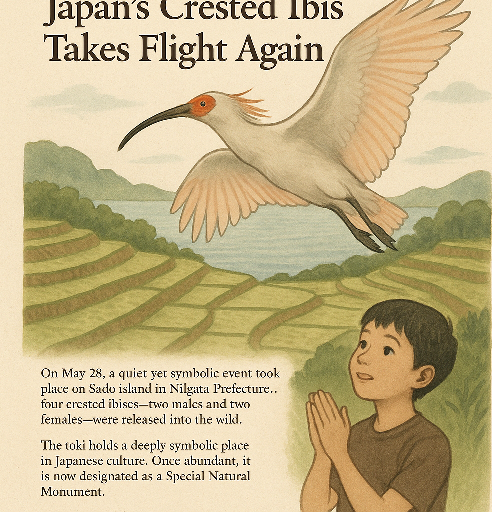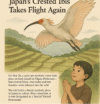
May 29, 2025
On May 28, a quiet yet symbolic event took place on Sado Island in Niigata Prefecture: four crested ibises—two males and two females, all one year old—were released into the wild. The release was part of Japan’s ongoing efforts to reintroduce the once-extinct toki (Nipponia nippon) into its natural habitat. What made this event even more special was the participation of veterinarians from Noto, Ishikawa Prefecture, where the first mainland release is planned for June next year.
The method used, called “hard release,” involved transporting the birds in wooden crates to a terraced rice field in the Shiidomari district on the eastern side of Sado Island. Local residents and elementary school students—about 80 people in all—watched with hope and admiration. One 11-year-old boy said he wished for the birds to thrive and become parents someday.
The toki holds a deeply symbolic place in Japanese culture. Once abundant in the Japanese countryside, it vanished due to habitat loss and pollution. The bird is now designated as a Special Natural Monument, highlighting both its cultural and ecological significance. For many Japanese people, the toki is more than a bird—it is a reminder of the fragile balance between humans and nature, and a call to preserve that harmony.
Since 2008, the Ministry of the Environment has been releasing toki on Sado Island. The wild population has now grown to about 580 birds, including the four released this time. However, as most birds have concentrated in the island’s central area, the government is working to diversify release sites to avoid overpopulation and increase survival and breeding rates. The upcoming release in Noto will mark a new chapter in this nationwide conservation effort.
The return of the toki is not just about saving a species—it’s about reconnecting with the rhythms of nature. It invites us all, Japanese and visitors alike, to reflect on how we coexist with the environment and what we must do to ensure its future. Watching the graceful flight of the toki is to witness a shared hope: that harmony between humans and nature can indeed be restored.
https://www.city.sado.niigata.jp/site/tokinomori
聖なるトキの放鳥:日本のトキが再び空へ
5月28日、新潟県佐渡島で静かではあるが象徴的な出来事が行われました。2羽のオスと2羽のメス、いずれも1歳のトキが野生に放たれたのです。この放鳥は、かつて絶滅したトキ(学名:Nipponia nippon)を自然の生息地に再導入するという日本の継続的な取り組みの一環です。今回の放鳥がさらに特別な意味を持ったのは、来年6月に本州で初めて放鳥が予定されている石川県・能登地方の獣医師たちが参加したことでした。
「ハードリリース」と呼ばれる方法が使用され、鳥たちは木箱に入れられて、佐渡島東部・椎泊地区の棚田まで運ばれました。地域住民や小学生など、約80人が希望と敬意をもって見守りました。ある11歳の少年は、鳥たちが元気に育ち、いつか親になってほしいと語りました。
トキは日本文化の中で非常に象徴的な存在です。かつて日本の田園地帯に数多く生息していたこの鳥は、生息地の喪失や汚染によって姿を消しました。トキは現在、「特別天然記念物」に指定されており、その文化的・生態学的な重要性が強調されています。多くの日本人にとって、トキは単なる鳥ではなく、人間と自然の間の壊れやすいバランスを思い出させ、その調和を守るための呼びかけでもあります。
2008年以来、環境省は佐渡島でトキを放鳥してきました。現在では、今回の4羽を含めて野生の個体数は約580羽にまで増加しています。しかし、島の中央部に個体が集中しすぎており、繁殖率や生存率が低下傾向にあるため、政府は放鳥地点の分散化を進めています。能登での放鳥は、この過密状態を避ける新たな段階となります。
トキの復帰は、単なる種の保存にとどまりません。それは自然のリズムとの再接続であり、私たちすべて、日本人も訪問者も共に、環境とどのように共生するか、そしてその未来を守るために何をすべきかを考えさせるものです。優雅に空を舞うトキの姿を見ることは、私たちが共有する希望—人間と自然との調和は本当に取り戻せる、という希望—を目にすることなのです。
https://www.city.sado.niigata.jp/site/tokinomori
